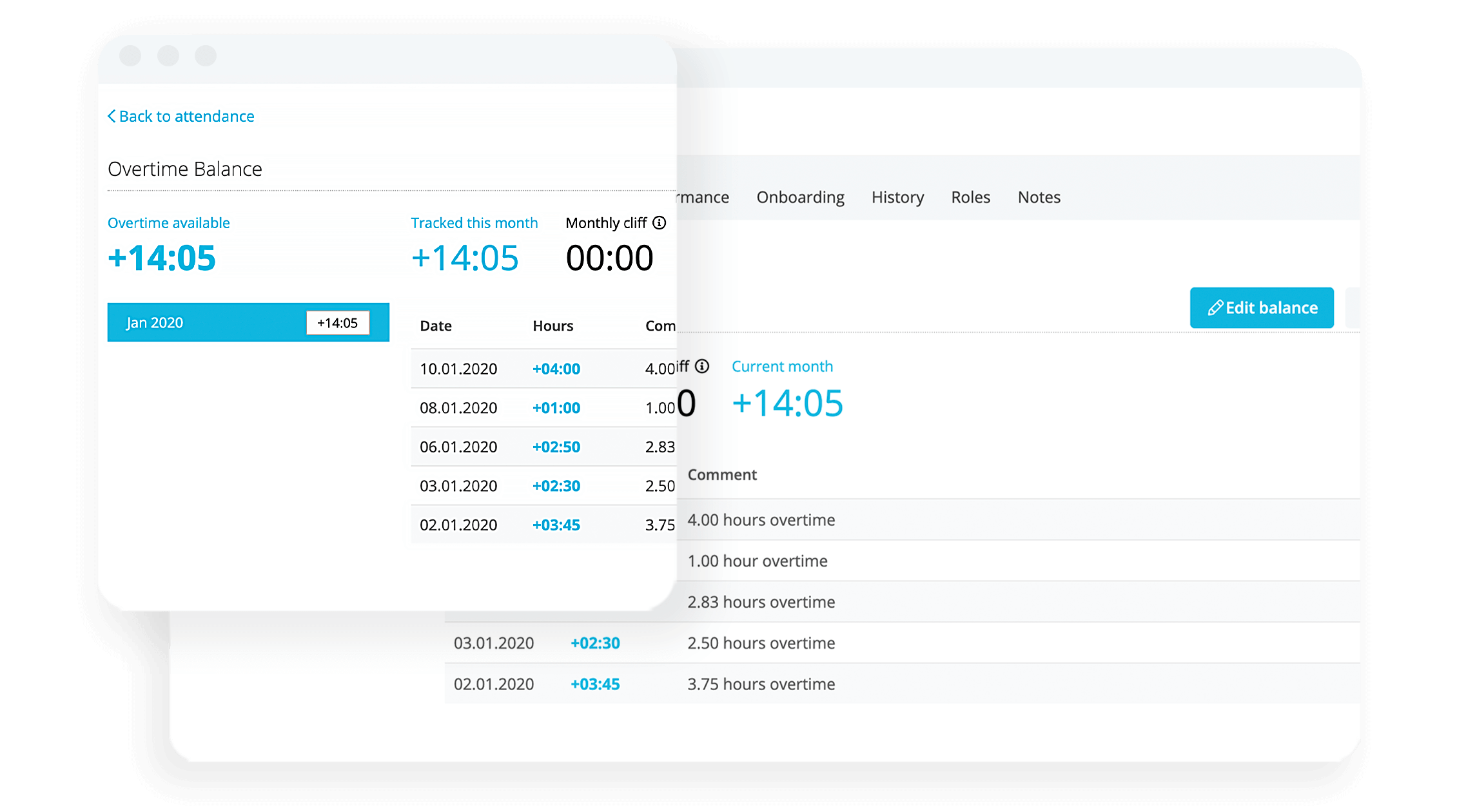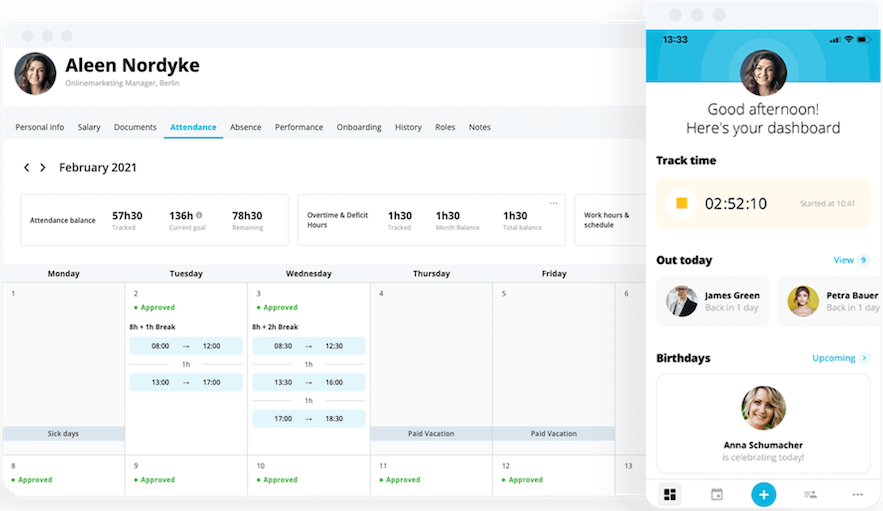How To Build A Workplace Rota

When it comes to making sure the right workers are available for the right shifts, it's not always easy to keep track. That’s why a work rota is so useful. This blog post addresses key issues about work rotas in the UK – including relevant legislation, how to create a good work rota, and what HR leaders can do to set themselves up for success.
Keep an overview of all working times with Personio. Click here to learn more.What Is Work Rota?
A work rota (also known as a schedule or roster) is a document, file or plan which lists the employees who need to do a certain shift, the dates and times at which they are scheduled to do it and their responsibilities.
How Is A Work Rota Used?
When organizations want to schedule the number of employees who work at specific times, they use a work rota to make sure that workers are allocated a fair number of shifts, with the right number of breaks, while ensuring that critical tasks are covered at all times.
In a work context, work rotas, rosters or schedules determine who works when, when they take breaks, and when they’re off duty. People who volunteer their time at a charity shop or a library, for example, will have their shifts or duty times documented on a rota, too.
Why Does A Work Rota Matter For Business?
Whether your employees are working in a factory, a hospital, a restaurant, a shop, a warehouse or any other context in which the right number of appropriately-qualified people must be available to do the work, the chances are that you’ll need a work rota to organise it all.
A work rota is, in some cases, a legally binding document that can be used to provide evidence of how many employees were working on a specific day, who they were, and where they were working. As an example, healthcare workers like nurses or home care managers must be documented particularly carefully to ensure patient safety.
It’s important to make sure that the work rota is done fairly, documented appropriately, managed carefully, and distributed widely.
Track your teams' time seamlessly

Enable your employees to enter their working hours in an efficient, legally compliant and secure system. See working hours at a glance across your company.
Get Smarter Time TrackingWhat Should HR Do To Create And Maintain A Good Work Rota?
When creating, maintaining and managing a work rota, common sense applies. Here are some of the most common considerations to keep in mind:
Make sure a work rota is controlled (so it can’t be changed randomly, by unauthorized people, or at the last minute)
Be clear on who is allowed to authorize any changes.
Ensure that even if staff can make recommendations or requests for changes themselves, that only one person is ultimately responsible for approving and allocating tasks and times.
There are also other important factors to consider specific to your work environment. For example, if you’re creating a work rota for an environment where particular skill sets are required, make sure that you get the right balance of people. Depending on how much your employees can overlap skill sets with others, you might need to bring extra people in – or have them available on standby – in case of absences or illnesses. Plan that into the rota, too.
What Are Some Of The UK Laws About Work Rotas?
The Working Time Regulations
Work rotas need to be made with employees’ rights in mind, particularly the UK’s Working Time Regulations (1998). For example, the UK law dictates the maximum number of hours a person may work (48 hours per week on average – normally averaged over 17 weeks), although employees can choose to opt-out of this.
Some people may need to work more than 48 hours a week on average. For example, the gov.uk website says those who work in the armed forces, emergency services or police, seafarers, domestic servants in a private household, those who work in security and surveillance and people who are in control and where working time is not measured (like a managing executive) may need to opt-out.
That’s why it’s important to ensure that your employees record the number of hours they work, and why you should help them stay on top of their work rotas in the quickest, easiest way possible.
Night Working Hours
Gov.uk notes that people working at least three hours during the ‘night period’ (usually 11 pm to 6 am) are classified as night workers. Workers and employers can agree on a different night period lasting 7 hours, including midnight to 5 am, but they must put this in writing. The legislation says that night workers must not work more than an average of 8 hours in 24 hours. The rules are slightly different for workers aged 16 or 17, as they’re not allowed to work between midnight and 4 am – with a few exceptions.
Employers must keep records of night workers’ working hours so that they can show workers are not exceeding the limits – and they must keep these records for at least two years.
If you’re not recording these times and storing them, safely, you should be.
Overtime Pay
In the UK, employers do not have to pay workers for overtime – as long as their average pay for the total number of hours they work doesn’t fall below minimum wage. How much should they be paid? As is often the case, it all comes down to what’s in the employment contract. This should usually include details of overtime rates and how they’re worked out.
Employment contracts dictate payment terms as well as agreed working hours. But that information is useless if it can’t be connected with your payment system, and be verified easily! That’s why good software tools come in very useful when it comes to work rotas. When a work rota can be managed in one place, updated easily by employees (for example, using an app), and seamlessly import data into relevant payment systems, it frees up time to do more meaningful tasks, rather than just being data monkeys.
Rest Breaks
What are the laws around rest breaks in the UK? And how do these apply to work rotas? Again, gov.uk is the place to find the answer. Workers have the right to one uninterrupted 20-minute rest break during their working day if they work more than 6 hours a day. Note: this does not have to be paid (it depends on what’s in their contract). They also have the right to 11 hours’ rest between working periods and have the right to either 24 hours of uninterrupted rest time (without any work) each week, or 48 hours without any work each fortnight.
Changes To Working Hours
There are various scenarios when a worker’s working hours can be changed – but last-minute changes are stressful for workers and should be avoided, if possible. As an employer, as long as you follow the legal requirements above as well as the terms of an employee’s contracts, you should be okay – but most employment law and contract advisors also recommend that you don’t make changes with less than 48 hours’ notice, if possible. If in doubt, it may be worth reading this article in safeworkers.co.uk about the law around contracted working hours, and employees’ rights in the UK when it comes to changing working hours.
Track your teams' time seamlessly

Enable your employees to enter their working hours in an efficient, legally compliant and secure system. See working hours at a glance across your company.
Get Smarter Time TrackingHow Can A Business Be Set Up For Success?
The easier a work rota is to maintain, the better. Some companies start by creating a work rota template, so at least they don’t have to re-create the formatting each time. But that’s just the beginning. Ideally, a rota should be digitised. However you choose to manage a work rota, here are some tips to do it well:
Make it quick and easy to create a work rota.
Make sure it covers your business needs so you aren’t short of the right types of staff.
Give workers as much advanced notice and stability as possible.
Make it accessible from wherever it’s most convenient for them.
Make it easy for workers to read and understand – so they’re clear on when they need to be working, where, and what they need to be doing at the time.
Make sure all the information relating to their work rotas (and payment, time off, the maximum number of hours worked etc.) is stored in one place and easily cross-referenceable.
Make it easy for everyone to know that they’re using the most up-to-date version of their work rota! There’s nothing worse than someone arriving late for a shift (or not at all) because they didn’t realise that the rota was updated.
How to Make Work Rotas Easy To Manage
One great way of making work rotas easy to manage is by using attendance tracking software. With the right software HR teams and managers can create rotas more efficiently, and be legally compliant. It’s easier for managers to see all working hours at a glance – and good software makes it easy to stay up to date in real-time, and analyse the data with work-time-specific reports. One of the best features of great attendance tracking software, though, is the ability to calculate salaries and overtime based on working schedules!
With a people workflow automation solution like Personio, you can spend less time managing other people’s time and more time doing meaningful work.

